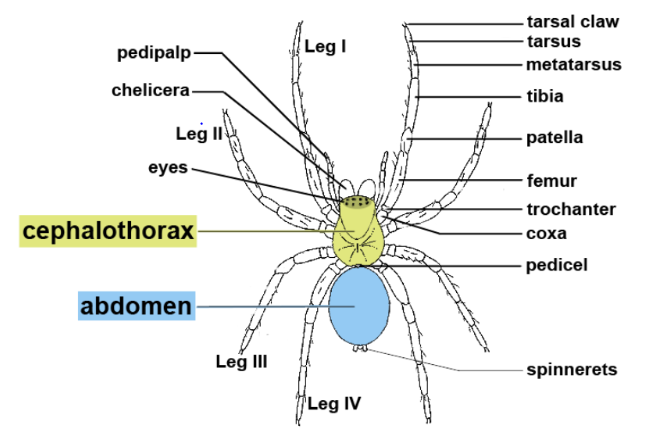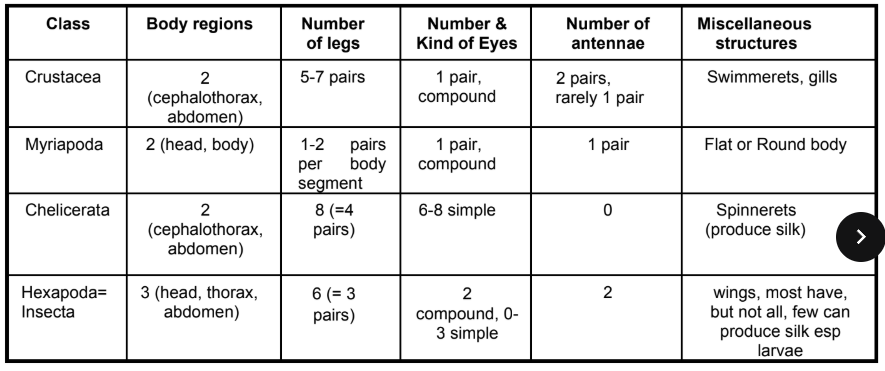T1 ARTHROPODS - DISTINGUISHING FEATURES OF INSECTS AND ARACHNIDS
1/39
Earn XP
Description and Tags
T1 DISTINGUISHING FEATURES OF INSECTS AND ARACHNIDS
Name | Mastery | Learn | Test | Matching | Spaced |
|---|
No study sessions yet.
40 Terms
Another term for arthropods
PHYLUM ARTHROPODA
arthropods
animals with jointed or segmented body and appendages. They are characterized by external skeleton consisting mostly of chitin, and a segmented body where individual segments are often fused together
tagmatization
individual segments are fused together
4 main characteristics of arthropods
• Bilaterally symmetrical animals
• Segmented body
• Paired jointed appendages
• Development is complete or incomplete. The life
history may include different forms (egg to adult)
Arthropods exoskeleton are?
flexible and chitinous
when the males and females of the same species have very different characteristics
sexual dimorphism
Arthros means
joints
Podos means
foot
Poda means
feet
Segments
divisions or sections of the body and appendages, and each segment could be detached cleanly from another or from where it is attached.
Appendage
a structure with one end attached to body and the other end is dangling (e.g. antenna, legs, wing, etc)
5 subphylas of arthropoda
Hexapoda
Chelicerata
Crustacea
Trilobitomorpha
Myriapoda
Insects
Hexapoda
spiders, scorpions, horseshoe crab, mites and ticks
Chelicerata
Trilobites
Trilobitomorpha
Crabs, Shrimps, Lobsters, pillbugs, barnacles
Crustacea
Millipedes and centipedes
Myriapoda
Trilobitomorpha
All are extinct and preserved as fossils. Formerly numerous marine animals
Crustacea
terrestrial, fresh water or marine animals.
2 segments of a crustacean
head + pereon and pleon
Myriapoda
These are terrestrial and air-breathing arthropods. Their body is made of many similar segments.
Has more than 11 pairs of legs
Myriapoda
2 segments of myriapods
head and trunk
Chelicerata
Their body is divisible into anterior prosoma (Cephalothorax) or head (Gnathsoma), and abdomen (posterior opisthosoma) or (idiosoma)
2 classifications of chelicerata
arachnids and merostomata
Arachnids
• Two body regions (head=cephalothorax and abdomen)
• Cephalothorax with 6 pairs of appendages (chelicerae, pedipalps and 4 pairs of
walking legs)
• Abdomen with up to 3 pair of appendages (spinnerets)
• Mostly terrestrial and predatory, some secondarily aquatic and sap-sucking

What do spiders have that mites dont?
pedicel
pedicel
a slender waist separating the cephalothorax and the abdomen.
Segments of a spider
cephalothorax and abdomen
2 segments of a mite
gnathsoma and idiosoma
Hexapoda
Insecta. These are terrestrial and aquatic arthropods. Body is divided into 3 distinct regions (head, thorax, and abdomen).
the dominant terrestrial animal life on Earth.
insects
they are well over 1 million different known species of insects in the
world, and some experts estimate that there might be as many as 10 million.
Insects
Only invertebrates with wings and only animals with true wings
Insects

Characters of Arthropoda
mostly aquatic, wit 2 body regions and 5-7 pairs of legs
crustacea
terrestial, with a flat or round body, more 11 pair of legs and has 1-2 pairs of legs per body segment, has 2 body regions
myriapoda
has 4 pair of legs with 6-8 simple eyes and no antennae, with 2 body regions
chelicerata
has spinnerets and can produce silk, no antennae
arachnids
3 body regions, 3 pair of legs. 1 pair of antennae and may have wings
hexapoda